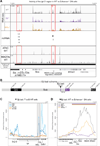Active and Inactive Enhancers Cooperate to Exert Localized and Long-Range Control of Gene Regulation
- PMID: 27239026
- PMCID: PMC4899175
- DOI: 10.1016/j.celrep.2016.04.087
Active and Inactive Enhancers Cooperate to Exert Localized and Long-Range Control of Gene Regulation
Abstract
V(D)J recombination relies on the presence of proximal enhancers that activate the antigen receptor (AgR) loci in a lineage- and stage-specific manner. Unexpectedly, we find that both active and inactive AgR enhancers cooperate to disseminate their effects in a localized and long-range manner. Here, we demonstrate the importance of short-range contacts between active enhancers that constitute an Igk super-enhancer in B cells. Deletion of one element reduces the interaction frequency between other enhancers in the hub, which compromises the transcriptional output of each component. Furthermore, we establish that, in T cells, long-range contact and cooperation between the inactive Igk enhancer MiEκ and the active Tcrb enhancer Eβ alters enrichment of CBFβ binding in a manner that impacts Tcrb recombination. These findings underline the complexities of enhancer regulation and point to a role for localized and long-range enhancer-sharing between active and inactive elements in lineage- and stage-specific control.
Keywords: Igk; Tcrb; enhancer-sharing; gene regulation; localized and long-range contacts; nuclear architecture; super-enhancer; transcription factor binding; transcriptional output.
Copyright © 2016 The Author(s). Published by Elsevier Inc. All rights reserved.
Conflict of interest statement
The authors declare that they have no competing financial interests.
Figures




References
Publication types
MeSH terms
Substances
Grants and funding
LinkOut - more resources
Full Text Sources
Other Literature Sources
Molecular Biology Databases

